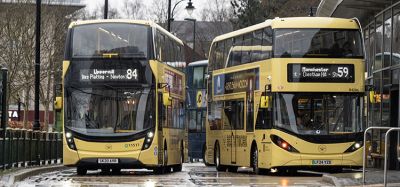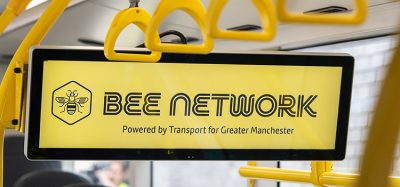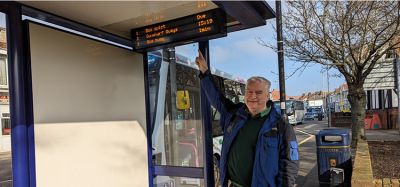Berlin-Brandenburg: Providing reliable passenger information
- Like
- Digg
- Del
- Tumblr
- VKontakte
- Buffer
- Love This
- Odnoklassniki
- Meneame
- Blogger
- Amazon
- Yahoo Mail
- Gmail
- AOL
- Newsvine
- HackerNews
- Evernote
- MySpace
- Mail.ru
- Viadeo
- Line
- Comments
- Yummly
- SMS
- Viber
- Telegram
- Subscribe
- Skype
- Facebook Messenger
- Kakao
- LiveJournal
- Yammer
- Edgar
- Fintel
- Mix
- Instapaper
- Copy Link
Posted: 3 March 2014 | Hans-Werber Franz, Verkehsverbund Berlin-Brandenburg GmbH | No comments yet
Verkehrsverbund Berlin-Brandenburg GmbH (VBB) is Germany’s largest association in terms of area. It is a municipal association owned by the federal states of Berlin and Brandenburg as well as the cities and districts in Brandenburg. The 40 transport companies making up the association offer their transport services to the approximately six million residents and visitors to the capital’s region in the form of approximately 1,100 train and bus lines across an area of some 30,000km2. This all happens in a very diverse region – from the metropolis of Berlin with its dense and high-quality public transport network to the rural regions of Brandenburg, where the population density, in some cases less than 30 residents/km2, is making traditional public transport services increasingly difficult…


Verkehrsverbund Berlin-Brandenburg GmbH (VBB) is Germany’s largest association in terms of area.
Latest passenger information – important for public transport
As the attractiveness of the overall public transport system is largely based on reliable passenger information, one of VBB’s main tasks is to ensure functioning company-wide electronic timetable information for the entire region. The Federal States of Berlin and Brandenburg have thus entrusted it to operate the state public transport information system and the ‘VBB-Fahrinfo’ timetable information facility (HAFAS / supplier: HaCon GmbH, Hannover) which provides users with contemporary functions both on the Internet and via apps on mobile devices. This service requires VBB to act as a partner in the DELFI network extending passenger information across the whole country of Germany and offering its information to international users as part of EU-Spirit.
Given customer expectations and the rapidly increasing use of mobile services, up-to-date information on disruptions and changes is of great importance. This prompted VBB to create an association-wide concept at an early stage, informing passengers and monitoring connections through multiple operators based on real-time data – an initiative which has almost been implemented to its full extent in recent years.
VBB-Fahrinfo
The demand for information on the Internet and from apps is constantly growing, which is why VBB is offering a contemporary information service through its VBB-Fahrinfo on the Internet and its Fahrinfo apps. In doing so, VBB-Fahrinfo not only provides timetables, maps and fare details but also barrier-free information and now even real-time information from 12 data suppliers (transport companies/co-operations of several companies). This real-time data is displayed on departure boards and is used to calculate alternative routes in the event of a disruption (so-called ‘re-routing’). Moreover, disruption information is also increasingly being taken into account, which is collected and provided by the transport companies via the HAFAS tool ‘HIM’ (HAFAS Information Manager). Due to the participation in the national and international information networks, DELFI and EU-Spirit information can also be provided in neighbouring regions, e.g. from the VBB region to Poland.
The web version of VBB-Fahrinfo remains in keeping with the design of the VBB’s main website1 and the latest technology enables additional information and special setting options to be minimised graphically. But users can still find them very easily and expand them in order to view and use the content.
In addition to the stationary and mobile Internet (currently launching: the HTML5 version), apps for iPhone and Android Smartphones offering a wide range of typical Smartphone functions are also available. The VBB apps have now been downloaded over 600,000 times, ensuring wide prevalence and a rapidly increasing demand for information.
The displaying of maps, e.g. to view footpaths between the station and the destination address, has recently also been significantly improved by introducing the ‘Open Street Map’ (OSM) which is managed by users and contains much more detailed information and routes. This in turn improves footpath calculations, as cul-de-sacs, laneways, park paths and pedestrian bridges/tunnels are also included in the footpath search.
Real-time data and VBB data hub
With the help of federal subsidies the larger transport companies in Berlin and Brandenburg began procuring and installing ITCS as early as the 1990s. An initial phase saw these systems serve purely as a means of monitoring and co-ordinating their own vehicle fleet. In further stages, interfaces were also set up for the association’s timetable facility, VBB-Fahrinfo, and to monitor connections across multiple operators from/to Deutsche Bahn AG. The increasing competition on the railways in recent years has prompted several rail transport companies to render services within the association region. Direct interfaces straight to the operator, Deutsche Bahn AG, are no longer helpful to the transport companies if railway lines are operated by another rail transport company. That’s why VBB set up a data hub enabling real-time data to be exchanged between a transport company and several other transport companies or VBB using the existing interfaces. This means transport companies don’t have to worry about purchasing expensive additional interfaces or the complex process of affiliating themselves with new partner companies.
The ITCS of four transport companies were connected to the VBB data hub in late-2013, and 2014 will see most transport companies within the VBB area being able to exchange real-time data with other transport companies and the VBB through this data hub.
For example, the Dahme-Spreewald regional transport company (Regionale Verkehrsgesellschaft Dahme-Spreewald – RVS) south of Berlin receives punctuality forecasts from the Deutsche Bahn AG, the Berlin city train (S-Bahn) and the East German railway company (Ostdeutsche Eisenbahn -ODEG-) regarding the Königs Wusterhausen train station through the VBB data hub. The RVS control centre can react and hold its buses in the event of train delays, particularly in the evening – a real benefit for the transport company and its customers.
Some transport companies have invested in dynamic information displays for major transit stations and central bus stations. Being connected to the VBB data hub allows these companies to display their own lines’ arrivals and departures as well as those of their partner companies, thereby providing customers with all the necessary timetable information – in real-time.
Passenger information on displays
Information displays are everywhere nowadays. Stationary displays connected to the Internet or LAN can be found at train stations and stops and in the lobbies of public establishments such as authorities, universities and museums. Private enterprises such as hotels and tourism service providers are also increasingly using indoor and outdoor displays for advertising and information purposes.
VBB offers timetable information from its data pool to these providers through various interfaces. Data in HTML, XML and API formats work particularly well. Data transfer through the standard German interfaces VDV 453 and 454 is essentially reserved for the transport companies equipped with ITCS.
Timetable information displays provided by VBB have today been fitted at train stations (e.g. Cottbus), airports (Berlin-Schönefeld), hospitals, the customer centres of many transport companies and the lobbies of universities (e.g. Viadrina Frankfurt/Oder), hotels and youth facilities.
New: passenger information with real-time data on trains
Public transport customers today expect to receive up-to-date information on disruptions and changes before and even during their journey. In summer 2013, VBB and Ostdeutsche Eisenbahn GmbH (ODEG) took an important step forward in implementing the multi-operator passenger information and connection synchronisation system based on real-time data: monitors in the trains operating on lines RE2, RE4, RB33, RB35 and RB51 display the connections of other intercity trains, suburban city trains (S-Bahn), subways (U-Bahn), trams and buses within the VBB area before the arrival at each stop.
For the first time in Germany, these screens not only show the departure times and punctuality forecasts for the line of the operator but also for other operators and transport services providing travellers with up-to-date information on all public transport connections departing from the train station, sometimes even with details on delays or malfunctions. The system has been very well received and takes pressure off train staff.
The ODEG decided to procure the on-board display data through VBB’s DFI interface. As the VBB data hub was purely designed as a relay at the start of the project, the ODEG could have only obtained planning and actual data from the transport companies equipped with ITCS. In order to be able to send all timetable data to third parties through VDV interfaces 453 DFI and 454 AUS the functions of the VBB-Fahrinfo data hub were extended: if no actual data is sent to VBB from a transport company the VBB data hub uses the available timetable data in its VBB-Fahrinfo facility. After combining the target and actual data the result is retrieved via the DFI interface of the ODEG ITCS and displayed on the on-board monitors.
Successful for the passengers: co-operations with third parties
In addition to its own information services, VBB is also very open to co-operating with third parties to reach out to as many (potential) public transport users as possible. VBB has thus been running an external interface (API) which allows third parties to programme their own applications for services and to integrate public transport information from VBB-Fahrinfo. Application users thus receive the same connection information as they would get from a VBB service request. The demand for (test) access is constantly growing whether it is for end-customer services, university projects or just as a trial. The partners using this facility include Nokia HERE and the Berlin traffic information centre (Verkehrsinformationszentrale Berlin).
Other co-operations supported by VBB are taking things one step further in terms of multi-modal information providing customers with different services depending on the route. They can thus combine/select from car sharing, public transport, taxi and carpooling based on whether they want the cheapest, fastest or ‘greenest’ mode of transport. The services offered by moovel (Daimler) and waymate are examples of this.
As part of the open data initiative of the federal state of Berlin, VBB timetable data is also available for general use as a ‘GTFS data set’ under a CC BY 2.0 licence. This GTFS data is similarly passed on to Google for use in Google Maps Transit.
Outlook: what remains to be done
In light of the extensive innovations introduced in the recent past, VBB is curious to see how customers will accept VBB services in the future. Initial reactions to the online changes have been positive – especially in relation to the new OSM-based maps. The app ratings in the App Store and Google Play have also been extremely pleasing.
Important extensions to VBB services in 2014 will be mobile ticketing integrated into the VBB apps, introduction of a so-called ‘Mobility Map’ displaying the current locations of the public transport vehicles, elevator disruptions incorporated into the route calculation/selection and multi-modal routing which includes car sharing and bikes.
In terms of data used, VBB aims to display line routes and access points as accurately as possible. The precise location of stops is at the top of the to-do list when it comes to further increasing quality particularly for the apps. And with over 1,100 lines and more than 13,000 stops within the VBB area, it’s no mean feat if information has also to be kept up-to-date. So there’s still a lot to do!
Reference
Biography
Hans-Werner Franz studied business administration, political economics, sociology and justice, and finished with a degree in economics. Activities in different professions followed, in which he collected extensive experience from the transport, communications and management sectors. Hans-Werner worked as Marketing Manager at the Transport Authority Rhine-Ruhr and as Head of Marketing and Deputy Managing Director at the Frankfurt Transport Authority. As Managing Director of Cubic Transportation Systems in Germany, he was involved in solutions for the optimisation of modern sales systems in public transport.
Since November 2003, Hans-Werner has been Chief Executive Officer of VBB.
Related topics
IoT (Internet of Things), Travel & Passenger Information
Issue
Issue 1 2014
Related cities
Germany
Related organisations
Verkehrsverbund Berlin-Brandenburg GmbH (VBB)








